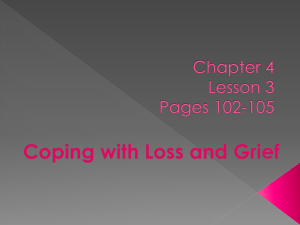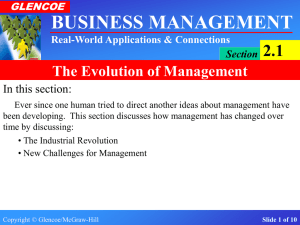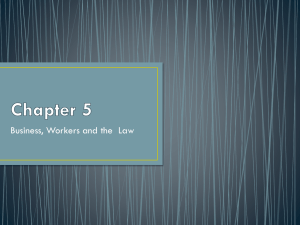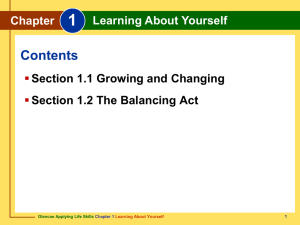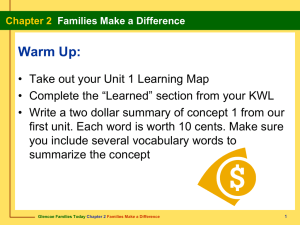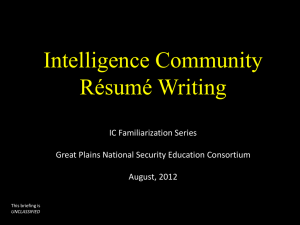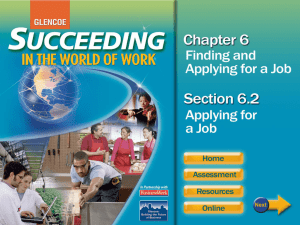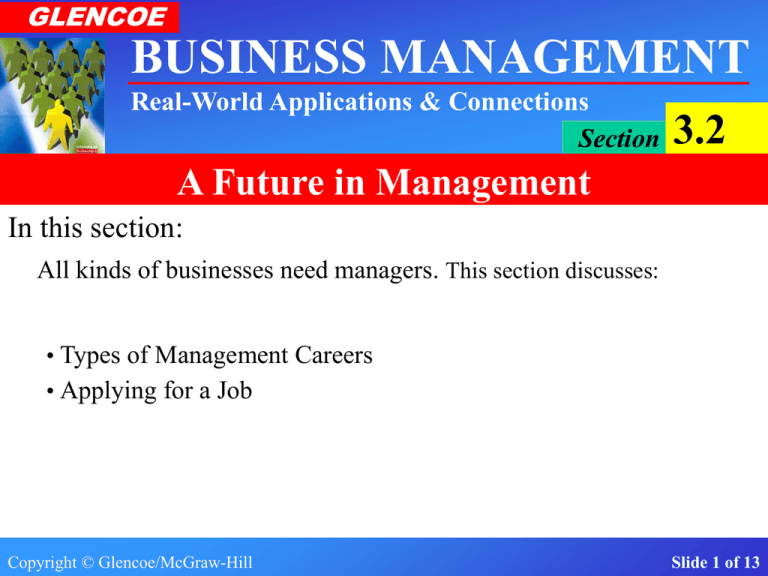
GLENCOE
BUSINESS MANAGEMENT
Real-World Applications & Connections
Section
3.2
A Future in Management
In this section:
All kinds of businesses need managers. This section discusses:
• Types of Management Careers
• Applying for a Job
Copyright © Glencoe/McGraw-Hill
Slide 1 of 13
GLENCOE
BUSINESS MANAGEMENT
Real-World Applications & Connections
Section
3.2
A Future in Management
What You’ll Learn
• The kinds of management careers available.
• The difference between for-profit businesses and nonprofit
organizations.
• How to write a résumé and cover letter.
Copyright © Glencoe/McGraw-Hill
Slide 2 of 13
GLENCOE
BUSINESS MANAGEMENT
Real-World Applications & Connections
Section
3.2
A Future in Management
Why It’s Important
To begin a career in management, you need to know what
management jobs are available and how to apply for them.
Copyright © Glencoe/McGraw-Hill
Slide 3 of 13
GLENCOE
BUSINESS MANAGEMENT
Real-World Applications & Connections
Section
3.2
A Future in Management
Key Terms
• for-profit business
• cover letter
• nonprofit organization
• chronological résumé
• résumé
• skills résumé
Copyright © Glencoe/McGraw-Hill
Slide 4 of 13
GLENCOE
BUSINESS MANAGEMENT
Real-World Applications & Connections
Section
3.2
A Future in Management
Types of Management Careers
1. For-profit businesses operate to earn money for their owners.
2. Nonprofit organizations operate to promote a special interest or
cause.
Copyright © Glencoe/McGraw-Hill
Slide 5 of 13
GLENCOE
BUSINESS MANAGEMENT
Real-World Applications & Connections
Section
3.2
A Future in Management
Estimated Growth in Some Managerial Occupations
Occupation
Accounting, Auditing,
& Bookkeeping
Health Services Managers
Holding &
Other Investment Offices
Copyright © Glencoe/McGraw-Hill
Approximate
1996 Employment
Projected Increase
by 2006
6,699
23.60%
1,417
37.70%
1,841
21.10%
cont.
Slide 6 of 13
GLENCOE
BUSINESS MANAGEMENT
Real-World Applications & Connections
Section
3.2
A Future in Management
Estimated Growth in Some Managerial Occupations cont.
Occupation
Approximate
1996 Employment
Projected Increase
by 2006
Management &
Public Relations
19,945
28.50%
Mortgage, Security, &
Commodity Bankers & Brokers
2,517
43.70%
Copyright © Glencoe/McGraw-Hill
Slide 7 of 13
GLENCOE
BUSINESS MANAGEMENT
Real-World Applications & Connections
Section
3.2
A Future in Management
When Applying for a Job
When applying for a job, you should know about
• Types of résumés
• Preparing a résumé
• Writing a cover letter
Copyright © Glencoe/McGraw-Hill
Slide 8 of 13
GLENCOE
BUSINESS MANAGEMENT
Real-World Applications & Connections
Section
3.2
A Future in Management
Types of Résumés
• Chronological résumé.
• Skills résumé.
• Computers and résumés
Copyright © Glencoe/McGraw-Hill
Slide 9 of 13
GLENCOE
BUSINESS MANAGEMENT
Real-World Applications & Connections
Section
3.2
A Future in Management
Preparing a Résumé
• Showcase what you have to offer.
• Be honest.
• Concentrate on your skills and education if you don’t have much
experience.
• Keep your résumé brief.
• Leave out any reference to your age, race, sex, marital status,
height or weight, or overall health.
Fig 2-1
Copyright © Glencoe/McGraw-Hill
Slide 10 of 13
GLENCOE
BUSINESS MANAGEMENT
Real-World Applications & Connections
Section
3.2
A Future in Management
Writing a Cover Letter
• Tell the company why you’re writing.
• Explain to the company why they should hire you.
• Ask for an interview in the closing paragraph.
Copyright © Glencoe/McGraw-Hill
Slide 11 of 13
GLENCOE
BUSINESS MANAGEMENT
Real-World Applications & Connections
Section
3.2
A Future in Management
Fact Idea and Review
1 What is the difference between a for-profit firm and a nonprofit
organization?
2. The purpose of a résumé and cover letter is to get you a job. True or
false? Explain your answer.
3. List three things you should not include on your résumé and explain
why you shouldn’t list them.
Cont.
Copyright © Glencoe/McGraw-Hill
Slide 12 of 13
GLENCOE
BUSINESS MANAGEMENT
Real-World Applications & Connections
Section
3.2
A Future in Management
Fact Idea and Review cont.
4.
Why do companies scan résumés and keep them in electronic
databases?
5.
What should you include in the first paragraph of your cover
letter? The last?
Copyright © Glencoe/McGraw-Hill
Slide 13 of 13

